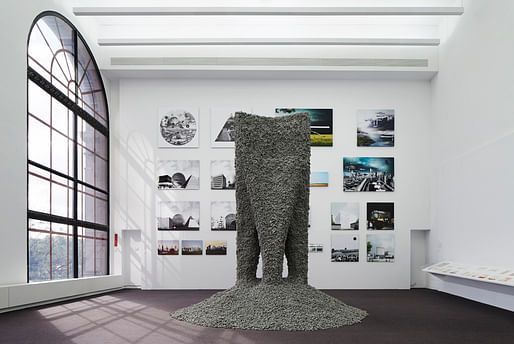

Rock Print, one of the most technologically-impressive installations at the Chicago Architecture Biennial, is the collaborative project of Gramazio Kohler Research of ETH Zürich and MIT’s Self-Assembly Lab. A towering stone assemblage put together by robots and secured with nothing more than thread, the installation is a reminder that feats of technical ingenuity can also be poetic.
According to the catalogue description, Rock Print “brings forward a new category of potentially random-packed, poly-disperse structures that can be automatically fabricated in nonstandard shapes.”
The project differs from existing jammed materials in that it operates on the macroscale, giving it potential architectural applications. And looking at its alien form, well-framed by a doorway into its room in the Chicago Cultural Center, the mind begins to run wild with the formal possibilities.

Perhaps most remarkable is that with the snip of a knife, the assemblage would fall to pieces (and it will, come closing in January) – although the stones can always be reused.
Strangely enough, this triumph of cutting-edge tech led my thoughts towards the past more than the future. Words like megalith or monolith immediately sprang to mind, although neither adequately fit the bill – both denoting a massive, singular stone, not a pile of pebbles like this.
“To build [in the past] meant to gather and mass material, allowing it to form empty cells for human shelter,” writes Rudolf Schindler in a 1912 manifesto, contrasting the architecture of the past with his ideas for the architecture of the future.
“Our efficient way of using materials eliminate the plastic sculptural mass,” the Viennese modernist states. “The contemporary architect conceives the ‘room’ and forms it with ceiling and wall slabs. The architectural design concerns itself with ‘space’ as its raw material and with the articulated room as its product.”
No doubt, there have been few architects as competent and sensitive as Schindler in handling this “new architectural problem” of space. Indeed, in the face of a built environment that appears increasingly generic and homogenized as a direct result of “our efficient way of using materials,” it’s easy to become nostalgic for the days of plastic sculptural mass, poché space, irregular surfaces, handicraft.

You don’t have to go far to find symptoms of some collective yearning for historic design qualities – and I don’t just mean the coffeeshop grotesqueries, oil-slicked facial hair, and other kitsch signifiers of the “cultural class” that populate the Silverlakes and Williamsburgs of the neoliberal world.
As much as any self-respecting designer hates to admit it, the proliferation of faux veneers smacked on to “honest” concrete or plaster surfaces in every mall in America admits some honest and collective longing for the days of dry wall construction. And it’s a shame that a sneer is most architects' knee-jerk reaction.
The future, it had seemed fated for quite some time, was to be surface. Continuous, flowing, even parametric perhaps – but surface all the same.
Rock Print is a much-need reminder that the remarkable potentials of robots, computer-modelling, and other new technologies do not absolutely determine the conditions of the design – or at least not in the singular manner we have become increasingly conditioned to imagine by sci-fi movies and sci-fi architects.
As novel and unusual its form is, Rock Print’s most compelling aspect was the way it recalled the massing structures of the past: a loop-like temporality elegantly matched to the coiled thread holding it up.
5 Comments
that is insanely awesome.
if it's an object sure, which is a very narrow view of it.
but the process and method developed is mind blowing and has massive potential.
Seems similar to 3D printing or sculpture.... Could reveal a process that informs a larger structure of philosophy ... Continuing with the theme of art vaguely related to architecture, but missing the architecture. Cool video though. Though it kind of dispels the notion of "self assembly" when there are people pouring rocks in, ha.
What is obviously missing is the design. Curators should remember just because you want that MIT tech cred, you need a designers hand involved. the sculpture itself is B-, kind of like a lame version of a Maya Lin
Very cool, and the element of danger when the loose rocks were allowed to fall was fun.
It definitely falls into the lineage of Richard Serra's Splash pieces, and very obviously illustrates a shift in the definition of power from the physical (at that time, manly) strength of the Process Art movement to today's power via computational (brain) strength.
quondam - it's like another way of doing math, that's why I'm excited. Don't really care for the final output and the fact if you cut the string the whole thing falls apart, sure whatever....
to paint it more broadly for potential
inexpensive granular irregular product in a box formed to be anything via an inexpensive material string. easy to reset.
Block this user
Are you sure you want to block this user and hide all related comments throughout the site?
Archinect
This is your first comment on Archinect. Your comment will be visible once approved.